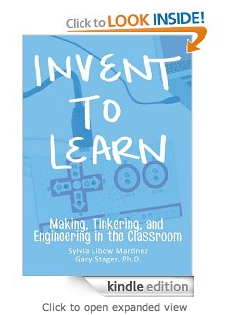This afternoon my poor husband re-experienced the concept that learning is social. The precipitating event was me starting to read Invent to Learn: Making, Tinkering, and Engineering in the Classroom by Syliva Libow Martinez and Gary Stager. Although he was trying to complete a number of other projects, I constantly interrupted his train of thought with my need to share what I was and learning, make exclamations, and to regaling him with fascinating tidbits of information. (Well, at least I found them fascinating.)
In an attempt to spare my husband further interruptions, I’ll try to do a bit of ruminating here instead.
The first reason I was so compelled to share the book with him was that reading the brief history making took me back to so many of our teaching roots. I was in college in the mid-1980’s. My assignments had me reading about basal readers and Hunterization. My free time was spent reading books such as The Open Classroom Reader by Charles E. Silberman. The type of teaching championed by that book was much closer to what I’d hope to be learning in my college classes than I was finding in my assigned textbooks.
Our first teaching jobs were at a student-centered, progressive, multi-age, parent choice program. Our teaching methods were informed by the research of Piaget, Dewey, Vygotsky, and the Whole Language movement. We worked hard to teach the entire child, addressing, social and emotional development along with academic progress.
In my early years of teaching I became involved with the Minnesota TAWL network and the Network of Progressive Educators. With such progressive roots, reading the introduction was like a meet up with old friends. Revisiting my early years of teaching made me realize just how constructive our curriculum was.
- Our students created cultures complete with myths, religions and artifacts from daily life. They even buried these items. Then they turned archeologist. They dug up middens and tried to reconstruct the culture from its artifacts.
- They read complete books and shared their thoughts in book clubs when most children were reading basals.
- They created a prairie. It became an outdoor classroom where we observed and interacted with nature. When it came time to burn the prairie, we used our letter writing skills to write letters to the surrounding homes and businesses. Those letters were the most revised (and most willing revised) student writing projects in all my years of teaching.
- When we delivered some of the letters to the nearby insurance office, the workers were standing on their chairs to see over their cubical walls. They wanted to figure out why children where there. Then they rushed over with the candy dishes from their desks to welcome the children.
- They built bird houses, took part in their own Medieval festivals, used computer simulations to explore the middle ages and performed abridged Shakespeare plays.
- Our librarian taught them cross stitch. Many of the children, including sports-loving boys, gave up outdoor recess to spend time in the library learning to stitch.
- Playground problems were resolved in class meetings with children being part of the solutions. Conflict resolution skills were taught in the classroom.
- Children met weekly in K-6 family groups to build community and their emotional intelligence.
- Primary classrooms were often converted into other environments, such as a rainforest, a castle or something else that supported the curriculum.
- Children conducted inquiry projects to research topics of their own interest.
Enough of my indulgent stroll through my memories. I list them here because so many of those activities fit with the types of activities described in the introduction to Invent to Learn. Listing them reminds me of how far we’ve swung away from that type of hands-on, project based, interdisciplinary learning. In the push to increase rigor and raise test scores, the disciplines have been pulled into artificial silos. As a result, the curriculum is disconnected and too large to be reasonably taught to children. Only in school is everything departmentalized. In most real life jobs, we draw on many disciplines.
In seeing how far from that we have come, the introduction gave me hope as it promotes the idea that making is a way to return to a constructional way of teaching and learning. It also gives me hope that our curriculum can better meet the needs of all learners, especially the students who currently struggle the most because they learn differently.
Time for bed. Rumination’s on chapter one will need to wait for another day.

